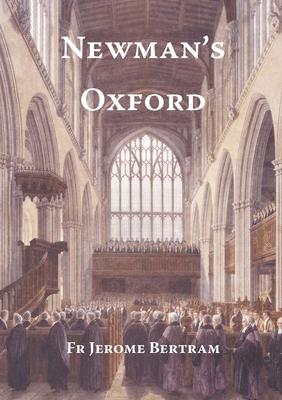The story of Newman entered a new phase with his beatification in September 2010 by His Holiness Pope Benedict XVI, followed so quickly by his canonization in October 2019. Henceforth "Newman" is no longer an historical character, the subject of an infinite number of research projects, the quarry for widely differing opinions on religious topics of all kinds--no, now he is "Saint John Henry", the subject of a local devotion, the prospective patron of new chapels and churches. No longer restricted to the mind for nominal devotion, now he can reside in the heart, for a devotion that is real. We have tried to illustrate it with views taken precisely at the time that Newman was living in Oxford, which was, fortunately, the great age of popular engraving on steel. Many of the steel engravings and woodcuts were prepared for the massive three-volume Memorials of Oxford by James Ingram, with engravings by John le Keux after drawings by F. Mackenzie, and woodcuts mostly by Orlando Jewitt after drawings by various artists. These volumes appeared in 1837, while Newman was at the height of his popularity; while complete copies are now rare, detached engravings and woodcuts can still be found easily in the High Street print shops. Other contemporary prints have been found to supplement Ingram, while local and national resources have been able to fill gaps. A splendid range of these prints and photographs is displayed in the library of Newman's "College" at Littlemore, in the care of the Sisters of the Work.

Newman's Oxford: The Places and Buildings associated with Saint John Henry Newman during his years in Oxford 1816-1846
The story of Newman entered a new phase with his beatification in September 2010 by His Holiness Pope Benedict XVI, followed so quickly by his canonization in October 2019. Henceforth "Newman" is no longer an historical character, the subject of an infinite number of research projects, the quarry for widely differing opinions on religious topics of all kinds--no, now he is "Saint John Henry", the subject of a local devotion, the prospective patron of new chapels and churches. No longer restricted to the mind for nominal devotion, now he can reside in the heart, for a devotion that is real. We have tried to illustrate it with views taken precisely at the time that Newman was living in Oxford, which was, fortunately, the great age of popular engraving on steel. Many of the steel engravings and woodcuts were prepared for the massive three-volume Memorials of Oxford by James Ingram, with engravings by John le Keux after drawings by F. Mackenzie, and woodcuts mostly by Orlando Jewitt after drawings by various artists. These volumes appeared in 1837, while Newman was at the height of his popularity; while complete copies are now rare, detached engravings and woodcuts can still be found easily in the High Street print shops. Other contemporary prints have been found to supplement Ingram, while local and national resources have been able to fill gaps. A splendid range of these prints and photographs is displayed in the library of Newman's "College" at Littlemore, in the care of the Sisters of the Work.